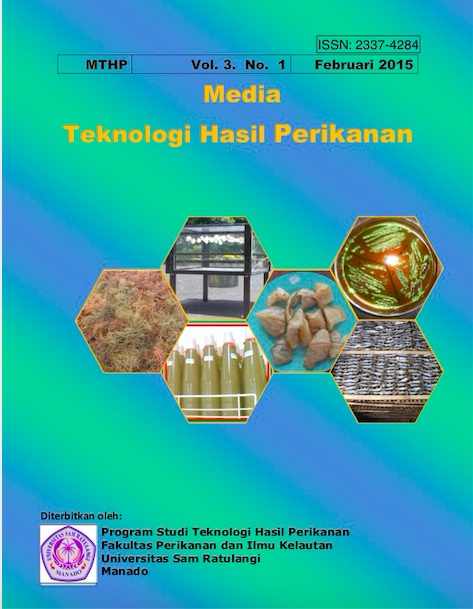KARAKTERISTIK ORGANIOLEPTIK OTAK-OTAK IKAN YANG DIBERI EDIBLE COATING KARAGINAN DENGAN PENAMBAHAN ASAP CAIR
DOI:
https://doi.org/10.35800/mthp.3.1.2015.8329Keywords:
Edible coating, Carrageenan, Fish cake, Liquid smokeAbstract
Edible coating is a new type of packaging made of biopolymer. The advantages of edible coating is enable to protect the food product, the original appearance of the product can be maintained and the product can be eaten as well as environmentally friendly. The study aim was to look at the organoleptic characteristics of fish cake coated with edible coating of carrageenan were given a liquid smoke. The treatments given were variation of carrageenan concentration i,e. 0%, 1%, 1,5%, 2%, 2,5%, 3%. The experiment was designed using a Completely Randomized Design (CRD). To determine the effect of treatments, the data were tested using organoleptical tests consists of hedonic and texture.
The results shown that hedonic test of the appearance and color of the raw sample have significant effect (p>0,05), while the other test showed no significant effect (p>0,05). However, the organoleptical score for taste, smell and texture shown a tendency that the fish cake coated, have higher score than without coated.
Â
Keywords: Edible coating, Carrageenan, Fish cake, Liquid smoke.
Downloads
Published
How to Cite
Issue
Section
License
Authors who publish with this journal agree to the following terms:
- Authors retain copyright and grant the journal right of first publication with the work simultaneously licensed under a Creative Commons Attribution License that allows others to share the work with an acknowledgement of the work's authorship and initial publication in this journal.
- Authors are able to enter into separate, additional contractual arrangements for the non-exclusive distribution of the journal's published version of the work (e.g., post it to an institutional repository or publish it in a book), with an acknowledgement of its initial publication in this journal.
- Authors are permitted and encouraged to post their work online (e.g., in institutional repositories or on their website) prior to and during the submission process, as it can lead to productive exchanges, as well as earlier and greater citation of published work (See The Effect of Open Access).







